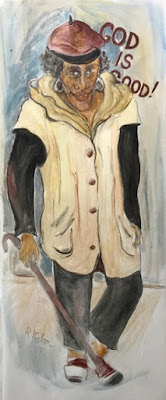 I’ve always been pretty good
at painting people but not very good at painting portraits. John Singer
Sargent, one of America’s greatest portrait painters, defined a portrait as a
painting with “a little something wrong about the mouth,” (loose quotation)
referring, of course, to the difficulty of capturing the planes of the area
around the lips, but also to the fact that what the painter sees and what the
subject hopes he’ll see are often two different things. Conventional
portraiture is not so much an art form as a skill, something that can be
learned, a form of pleasing psychophancy. Really good portrait painters manage
to capture the subject’s interior life as well as a likeness. There’s also a
great story about Picasso’s portrait of the poet, Gertrude Stein. When she
complained that it didn’t resemble her, his response was “Don’t worry. It
will.” (or words to that effect.)
I’ve always been pretty good
at painting people but not very good at painting portraits. John Singer
Sargent, one of America’s greatest portrait painters, defined a portrait as a
painting with “a little something wrong about the mouth,” (loose quotation)
referring, of course, to the difficulty of capturing the planes of the area
around the lips, but also to the fact that what the painter sees and what the
subject hopes he’ll see are often two different things. Conventional
portraiture is not so much an art form as a skill, something that can be
learned, a form of pleasing psychophancy. Really good portrait painters manage
to capture the subject’s interior life as well as a likeness. There’s also a
great story about Picasso’s portrait of the poet, Gertrude Stein. When she
complained that it didn’t resemble her, his response was “Don’t worry. It
will.” (or words to that effect.)
Portraiture goes back several
millennia to ancient Egypt when the pharaohs decided to place ‘photoshopped’
versions of themselves up there with their gods. Other ancient civilizations,
including the Greeks and the Mesopotamians also portrayed their rulers, but in a
stylized, non-realistic manner, more like gods than real people. It wasn’t
until the humanizing influence of the Early Renaissance that ordinary mortals
were deemed worthy of having their likenesses preserved. Over the centuries
there have been a great many artists who could capture a physical resemblance
but only a few who could - Pygmalion like - depict internal emotions as well as
exterior appearance. Giotto, Rembrandt among the more noted
 Once the camera appeared,
portrait painting was doomed. Why bother? The camera can do in a second what
would take weeks of hard labor and years of training to achieve in paint.
However, even after the invention of the camera painted portraits remained
popular producing some surprisingly great examples. Painters such as van Gogh
and Modigliani and many of the German Expressionists, Kokoschka and (my
personal favorite) Max Beckmann created portraits that went beyond mere
photographic resemblance. However, for most of the 19th and 20th
centuries photography has become the preferred way to record one’s appearance
for posterity.
Once the camera appeared,
portrait painting was doomed. Why bother? The camera can do in a second what
would take weeks of hard labor and years of training to achieve in paint.
However, even after the invention of the camera painted portraits remained
popular producing some surprisingly great examples. Painters such as van Gogh
and Modigliani and many of the German Expressionists, Kokoschka and (my
personal favorite) Max Beckmann created portraits that went beyond mere
photographic resemblance. However, for most of the 19th and 20th
centuries photography has become the preferred way to record one’s appearance
for posterity.
Today, good portrait painters
are few and far between. Most of them specialize in what I call “Imperial
Portraiture,” votive likenesses of Captains of Industry and Civic Leaders. And
now, in the current Age of the Selfie, there’s no need now for anyone to even
hire a photographer; the camera does it all.
 I have never been able to
“capture a likeness,” maybe because I never really worked hard enough to
acquire the necessary skills, but I am good at creating “life” in my
paintings. My goal is not to be a camera, but to get my subjects to talk to me,
look into my eyes and tell me what they are thinking, feeling. It’s a gift and
I have no idea how it came about. I recently completed a series of 54” x 24”
oil and charcoal sketches on canvas. I
intended to use them in a series of paintings of Harlem I’m planning to work on
next winter. However, I like the sketches so much I think I’ll stop right now.
There are six “characters” currently residing in my studio, and they’re great company.
I have never been able to
“capture a likeness,” maybe because I never really worked hard enough to
acquire the necessary skills, but I am good at creating “life” in my
paintings. My goal is not to be a camera, but to get my subjects to talk to me,
look into my eyes and tell me what they are thinking, feeling. It’s a gift and
I have no idea how it came about. I recently completed a series of 54” x 24”
oil and charcoal sketches on canvas. I
intended to use them in a series of paintings of Harlem I’m planning to work on
next winter. However, I like the sketches so much I think I’ll stop right now.
There are six “characters” currently residing in my studio, and they’re great company.
What an amazing cast of characters could be in film. Love them. Fs
ReplyDelete